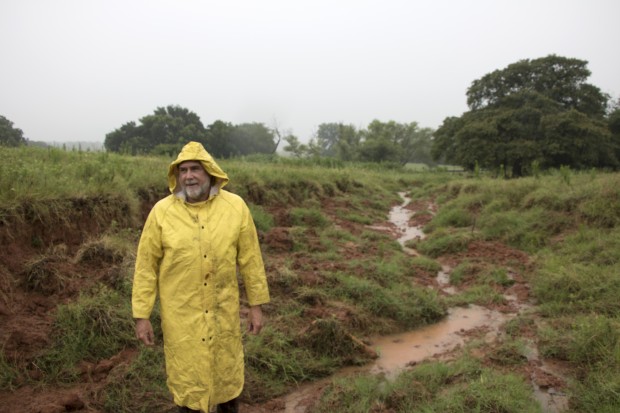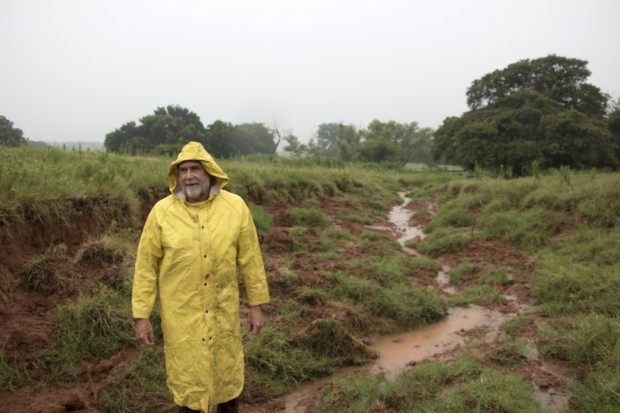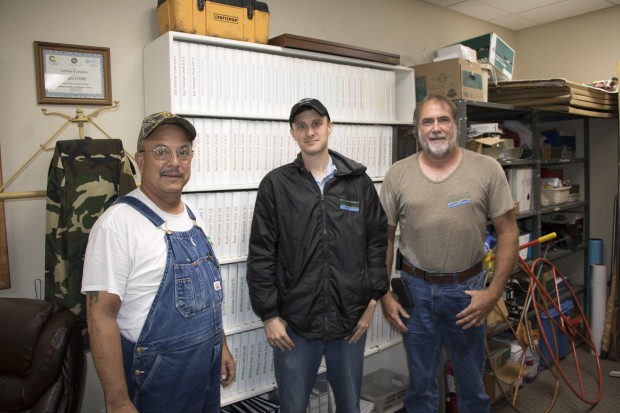
Oklahoma Conservation Commission Watershed Technitian Dennis Boney inspects damage to the Wildhorse 80 dam's spillway in Garvin County in July 2015.
Logan Layden / StateImpact Oklahoma


Oklahoma Conservation Commission Watershed Technitian Dennis Boney inspects damage to the Wildhorse 80 dam's spillway in Garvin County in July 2015.
Logan Layden / StateImpact Oklahoma

Logan Layden / StateImpact Oklahoma
Oklahoma Conservation Commission Watershed Technitian Dennis Boney inspects damage to Wildhorse 80's spillway in Garvin County.
More than 2,000 dams in Oklahoma have protected lives and property from flooding for decades. But age is catching up with them, and many need repairs. And this spring’s record rainfall is putting dams under even more pressure.
Catastrophic flooding used to just be part of life in Oklahoma. Ask anyone who was around in the late 1950s, like Allan Hensley, who grew up on Rock Creek in south-central Oklahoma.
“My dad took me down and showed me Rock Creek when I was a boy; and a beautiful corn crop,” Hensley says. “And the next day it was water, flooded.”
Rain beats down on us as we stand next to the Wildhorse 80 Dam. This waterlogged earthen dam has been trying to hold back a lot of water since April.
“Erosion like this can spread incredibly quickly,” Robert Hathorne, with the Oklahoma Conservation Commission, says.
Hathorne and Greg Lyons peer into a deep gash in Wildhorse 80’s emergency spillway, where swirling water has displaced soil that’s usually tightly packed with wildflowers and weeds.
“Six to eight foot deep, probably 200 foot long, 35 foot wide,” Lyons tells Hathorne. “There was just so much of it over the control section, it just finally washed out.”
The Conservation Commission team is here to inspect the dam, which holds back what amounts to a farm pond in an overgrown field, well off the beaten path. Lyons says the recent erosion only adds to Wildhorse 80’s problems.
“It’s five feet lower now than it should be. The tower has deteriorated. It’s a corrugated tower, and it’s got holes rusted in it,” Lyons says.
That means too much water is seeping through.
Wildhorse 80 is one of 146 dams Greg Lyons is charged with inspecting and maintaining.
That’s 146 dams for one guy.
The state Conservation Commission only has nine staff members to look after more than 2,000 flood control dams.
“I could use help, yes,” Lyons says. “I do my inspections. I try to do my mowing, spraying, tree and brush removal. It’s a lot on one person.”
Conservation Programs Director Tammy Sawatsky says Oklahoma’s repeating cycle of intense drought followed by devastating floods led to a push for dam construction in the first half of the 20th century.
“It really was a grassroots program that started with the locals trying to find something that they could do to prevent the flooding and losing their productive cropland,” Sawatzky says.
Locals pushed for dams, but the federal government paid for their construction.
“Most of the sites were built in the 60s, when they were finishing at least one dam a day,” Sawatzky says. “There are many people who have no idea that what they call the ‘farm pond,’ that maybe as a kid they went out and fished in it, that that is actually a flood control dam.”

Logan Layden / StateImpact Oklahoma
From left: The Oklahoma Conservation Commission's Greg Lyons, Robert Hathorne, and Dennis Boney at the conservation district office in Pauls Valley, Okla.
Then the dams were handed over to the state and local conservation districts to run and maintain. Now that the dams are reaching the end of their intended lifespans, they need upgrading and constant maintenance. There’s just one big problem: Money. State funding is hard to come by.
It will take about $4 million to provide the most basic maintenance this fiscal year. Upgrading the aging system is even costlier. Washington offered Oklahoma $32 million, but there was a caveat. The state would have to put up some money.
“We were needing $8.8 million to match those funds, and we didn’t get any funding for that,” Sawatzky says. “So, we have enough to do maybe one more rehabbed dam. After that we’re at a halt.”
“None of those numbers take into account the estimated six to eight million dollars in damage caused by the rain, like at the Wildhorse 80 dam, where Robert Hathorne looks out past the damaged spillway.
“To the person that owns that land, that’s their life savings. That’s their livelihood right there. That’s where they graze their cattle. That’s where they grow their wheat. And there are a number of ranches and farms down this way that are being protected by this structure,” Hathorne says.
The public may never even notice dams like this one, but they’re vital. Just from mid-April through mid-June, the Conservation Commission says they prevented about $134 million in flood damage.